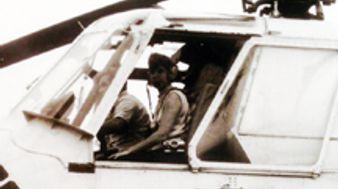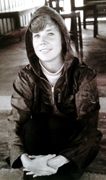Can you fly through a rainbow? Absolutely!
However, there are a few prerequisites. A helicopter helps!
Irene Baron: www.irenebaron.com
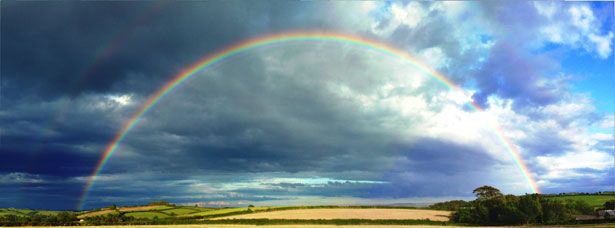 The majority of the population, not knowing much about meteorology, the physics of light, or the electromagnetic spectrum, would not believe it possible that someone could fly through a rainbow.
The majority of the population, not knowing much about meteorology, the physics of light, or the electromagnetic spectrum, would not believe it possible that someone could fly through a rainbow.
When you see a rainbow from Earth, the colors of the bow looks very narrow. Imagine being right beside it. Each band of color is about 20-feet wide when you're near the top of the arc.
When the EarthSky Internet site (http://earthsky.org/earth/can-you-ever-see-the-whole-circle-of-a-rainbow ) posted the factual information about people being able to see the whole circle of a rainbow, I thought I would pass the information on. The article explained the phenomenon a little and how pilots could see the whole circular rainbow. Some of the EarthSky comments include:
“It is indeed possible to see the whole circle of a rainbow – but conditions have to be just right.”
“Pilots do sometimes report seeing genuine full-circle rainbows. They’d be tough to see out the small windows we passengers look through, but pilots have a much better view from up front.”
“When sunlight and raindrops combine to make a rainbow, they can make a whole circle of light in the sky. But it’s a very rare sight. Sky conditions have to be just right for this, and even if they are, the bottom part of a full-circle rainbow is usually blocked by your horizon. And so we see rainbows not as circles but as arcs in our sky.”
WOW! I Flew Through A Rainbow!
During the Vietnam War in 1966, I worked for Battelle Memorial Institute under government contract to the Office of the Secretary of Defense, Advanced Research Projects Agency, Research & Development Center, Thailand (OSD, ARPA, R&D Center-Thailand). ARPA is now known as DARPA.
I was assigned to write the geology and hydrology sections of the classified document, Mekong River Project. This document was written for the U.S. military units who had to know ground conditions if the United States was placed in a position of having to defend Thailand. Every inch of the Mekong River was studied to learn where American troops could safely cross in case of war.
During the rainy season, the Mekong River flooded the surrounding land. The base of the river fluctuated over 40-feet as material during floods was moved downstream. At the time we were there, the Mekong River was the only major river in the world with no bridge across it.
The South East Asia Treaty Organization (SEATO) Agreement was in place. It obligated the United States to respond if Thailand was invaded. There were no useable maps or data available for our troops if case of war. They had to be created. ARPA had the contract to create the war manual for our troops anyplace along the Mekong.
Every section of the Mekong River bordering Laos and Thailand had to be studied, mapped, photographed and data entered into the publication. Thai engineers walked every stretch of the river before I directed the aerial photography. I didn't know what the day was going to bring. Being shot at again from both sides of the river was common. I wasn't expecting to witness a phenomenon rare to the human eye and normally visible only to angels.
This was during the Vietnam War. I sat in the Sikorski Helio-19 helicopter in the cockpit alongside the pilot. As Director of Aerial Photography, I determined how the helicopter was to be situated in the air each time photographs of the river and surrounding land were taken. Thai field engineers with Pentax cameras were in the lower level of the helicopter along with a few Americans. All 35mm film was black and white.
The pilot's name was identical to my uncle who was the former Major John Moore, USAF, also a pilot. As usual on these flights, I was the only female in the aircraft.
The Air America/CIA helicopter had been painted white. The reason for the coloration was that helicopters were being shot at by the Laotians who didn’t recognize who they belonged to. When that earlier coloration was changed to white, no one on the ground seemed to know what country they were from, and everyone shot at them, including the Thais. Air America officials thought the all white would make the helicopters safe. It didn’t. White helicopters were shot at from both countries because neither of them recognized them as friendly. Were we shot at when I sat left seat on this trip? YES. From Laos.
We had been flying on the southern side of the Mekong River when a small storm (cumulonimbus) moved in from the west. John looked around for the least populated area in which to land as we didn’t want to cause any ground activity and didn't want to be attacked. We didn’t want to be near anyone, but had to land until the storm passed. We let down in what we thought was an area devoid of people. Not so. Within fifteen minutes a crowd of barefoot men, women and children surrounded our helicopter, staying at a distance of about 40-feet. They formed a semi-circle around the side where the door had been previously removed and a thick rope was attached across the helicopter opening. As far as I knew, we had no weapons on board. No weapons were visible among the spectators.
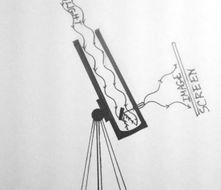 To get out of the helicopter, since I was in the co-pilot seat, I had to leave by exiting through my side window and climbing down the outside using the toe and hand holds. See photo to the left. The pilot did not get out of his seat in case we had to leave quickly. He did leave his side window open. Note, on a private or commercial aircraft, the copilot seat was right-seat. On the helicopter, it was left-seat. John, the PIC (Pilot In Command) was right seat.
To get out of the helicopter, since I was in the co-pilot seat, I had to leave by exiting through my side window and climbing down the outside using the toe and hand holds. See photo to the left. The pilot did not get out of his seat in case we had to leave quickly. He did leave his side window open. Note, on a private or commercial aircraft, the copilot seat was right-seat. On the helicopter, it was left-seat. John, the PIC (Pilot In Command) was right seat.
Thai engineers stepped out onto the flat field. We offered chocolate to the children who stayed with their parents. All the spectators were quietly talking a little among themselves. I walked toward the people who had been attracted to the site by the noise of the helicopter landing, stopping about 10-feet from them. I held out the candy and said the word, “chocolate.” After five or so minutes, some children stepped to me to take some candy. Once they did, other children ran up. None of the adults got closer. Thai engineers explained our situation to the bystanders. The adults had on different style straw woven hats. By the style of the hats we could easily pick out what adults were from Cambodia, Laos and Thailand. There was an even mix in the crowd. I would estimate there were about forty spectators, including children. At that time, Laotian hats were a wide cone shaped with torn cloth used as a strap from the lower edges of the hat and going under the chin. The Cambodian hats were similar to a western hat in the USA but loosely made and with rough edges. The Vietnamese hats were various were more rounded with a round raised area in the center. The underside of those hats were more ornate in weave.
When the storm passed, PIC John had us get back on board. The Thai engineers stepped in while I climbed up the outside and slipped into the left seat beside John. After buckling my safety harness, John ensured everyone was on board and the rope in locked position. The engineers had to be careful they didn’t get too close to the door opening unless they were directed by me to take photographs. We didn’t need all the engineers who were on board, nor the Battelle personnel who wanted to come along.
We needed only one engineer and several cameras to make sure one worked. But since the space was available, they took advantage of the flight to create an adventure and used their Battelle employment/association to see the countryside from the air. John and I had headsets with ear speaker/protectors and microphones. Those in the lower level couldn’t hear the conversations between Jon and I unless John keyed the microphone for them to listen. He began preflight procedures and when ready, took off. We were heading toward the east, rising in altitude with the afternoon Sun behind us.
Once in the air, as we rose in altitude, John and I saw the rainbow off in the distance. We admired it and talked about it with one another. John made the comment that it seemed to be getting bigger. It was. It was higher than us, but we were rising in altitude right toward it.
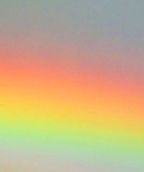 When you’re looking at a rainbow from the ground, it looks like some little curved strip of colored, spectral lights in the sky, maybe an inch or so wide. That’s what it looked like at first as we took off from the ground. As we rose in the air and flew toward it, the width of the colored bands of light appeared wider and wider, top to bottom.
When you’re looking at a rainbow from the ground, it looks like some little curved strip of colored, spectral lights in the sky, maybe an inch or so wide. That’s what it looked like at first as we took off from the ground. As we rose in the air and flew toward it, the width of the colored bands of light appeared wider and wider, top to bottom.
I looked out the side window and was awed at what I saw. I said, “John, look how it arcs down toward the ground!” He looked and remarked about how flat the rainbow looked. The rainbow was perfectly flat and arced in a circle that was on, what appeared to be, one flat plane. It would be like if you put a gigantic circular protractor in the sky and painted the edge with stripes of colored light. We couldn’t see the bottom of the rainbow as it went beneath us. We could see the growing size of the top of the rainbow, where we were headed, and the sides arcing off and down to the right and left of us.
We looked out each others’ side windows to compare the flatness of the arcing light on each side. It was really beautiful. We just gawked at what we were seeing. As we approached the rainbow, it had grown so big, we had to lean forward to look up at the top of it and down at the bottom. Each band of color had grown to about 20-feet in vertical size. I had no idea that a rainbow would be that big as you approached it, for from the ground it appeared so small.
With distance everything appears smaller. As you approach far objects, they appear larger and grow to their true size as you reach them.
We didn’t change our climb rate and headed for the area where the yellow and green bands of rainbow light met. Getting closer, the side view still showed the flat plane of arc which was circular as far as we could see. The rainbow colors appeared more brilliant, but not with deepening color. The brilliance was from reflected sunlight appearing brighter and more transparent.
John asked, “Can you believe this?”
“No,” I replied, astounded at what was happening. Totally in awe of being able to experience one of nature’s miracles. I am one of those persons who, when I see something, just stare at it. I don’t think of taking a picture to document it. I finally did, however, and asked one of the engineers for a camera. I didn’t bring one since we had about twenty of them below. Every camera supplied to the engineers by ARPA was a Pentax SLR film camera. Even though they all had black and white film, the camera would have taken a good image of the arcing light. While they talked, arguing whose camera would be passed up to me, time passed.
Then, it was too late for a camera. We had entered the rainbow. As we did, the color of the green band we entered ceased. Instead, what must have been every drop of rain in the arc reflected white sunlight. It was as if a million miniature suns flashed in our eyes at once. It blinded John and I instantaneously. Everyone below started yelling, “What was that?” “Did you see that?” “Are we being shot at?”
They thought the brilliance they saw was being given off from mortar rounds. All the people in the lower level were waiting for a shock wave/concussion from exploding artillery. All they saw was the brilliance of the rain droplets reflecting the sun. They never saw the rainbow. They kept asking, “What was that?”
John and I looked at one another. He asked me, “What do I tell them?” I shrugged and shook my head. He keyed the mike and replied to them, “Nothing. Don’t worry about it.” To me, he said, “They’d never believe it anyway.”
I agreed. What we saw through that experience was magnificent. Since that time I have tried to find other people who have flown through rainbows. I’ve been told a relative or “friend of a friend” commercial pilot had experienced the same thing. I learned that commercial pilots sometimes have flown through rainbows. I would love to meet some of them and discuss their experiences to see how their experiences compare to mine. I wonder if all rainbow bands would be the same vertical size?
7 OCTOBER 2016: ADDITION TO THIS POST. The picture below was posted on Facebook by Joanne Rossi and Erin France as taken by a pilot flying through a rainbow. I have inquired as to the name of the pilot but have yet not been informed. Anyone else have such a photo?
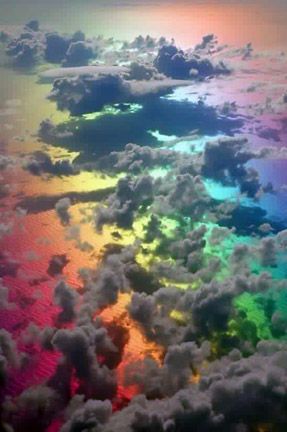 What would be the conditions that created this situation? How could such a thing happen? What conditions must be met for an aircraft to fly through a rainbow?
What would be the conditions that created this situation? How could such a thing happen? What conditions must be met for an aircraft to fly through a rainbow?
In my opinion, the vertical sheet of rain creating the rainbow had to stop. I remember as a young girl driving on a summer day. We would go through a sheet of rain about 4-5 feet thick, like a blip of rain on the windshield. To look back at the highway, there was one small area of wet. There was no other rain anyplace except for the one strip crossing the highway and across the farmland. Maybe the rain we went through was like that. Narrow in east-west depth, but over a mile wide. When we went through the rainbow, it was first brilliant color, then more brilliant white light of solar reflection, and immediately after, blue sky. Bam! Bam! Bam! And it was over.
The rain didn’t go on forever or the rainbow would have also. As the storm dissipated, the rain lessened. What we went through when we entered the rainbow was more of a mist. There was very little on the windscreen after we went through the rainbow. What little there was blew off. John and I talked about the experience, both of us totally amazed at what we had seen. We debated turning around to try it again, but it would be taking us off our already delayed travel time. We had to take more pictures and end up at Nakorn Phanom air base. Even if we did turn around to try it again, there was no guarantee we would be at the perfect angle to see the rainbow again. On such a hot day (over 90-degree air at the ground) there would be no guarantee the rain would remain. It may already be evaporating back into the atmosphere as nano-sized water vapor.
When I eventually returned to my home town in Ohio, years later, I located a private Cessna-172 pilot who agreed to take me up on a moment’s notice after an afternoon storm rolled through the area. He said he’d be glad to take me up if the flying conditions were not dangerous. I explained why I wanted to repeat the experience. It was to hopefully find a rainbow, fly through it, and document what we would see with colored photographs. The pilot later became one of my main pilots for aerial photography since he was a commercial pilot. It is an FAA requirement for aerial photographers to have a commercial pilot as PIC when they are taking contracted photographs.
I learned there are many skeptics in the human population who would not believe flying through a rainbow is possible. That doesn’t bother me at all, for I know what is true.
When you next look at a rainbow far off in the distant sky, think to yourself how small objects look at a distance. Then imagine how large the rainbow must really be to appear big enough for you to see it. You will quickly realize the whole vertical width of all the colored bands of rainbow at the top of the arc is over a hundred feet. Each band of color is about 20-feet high.
There are seven bands of colors which include red, orange, yellow, green, blue, indigo and violet.
Notice the inner section of the rainbow is lighter and brighter in color. The rest of the sky appears darker in appearance. That lighter and brighter area must be where raindrops are reflecting sunlight as white light. When you look at a rainbow, look up to see another one. I think the record is seven, one after the other. We only saw one. There may have been more, but we were mesmerized seeing that one.
WHAT AN EXPERIENCE! It was truly a gift from God.
Read more about the Sikorski Helio-19 at:
http://aircraft.wikia.com/wiki/Sikorsky_H-19
https://www.youtube.com/watch?v=M5i2XRweAvE
http://www.heli-archive.ch/en/helicopters/in-depth-articles/sikorsky-s-55h-19/
